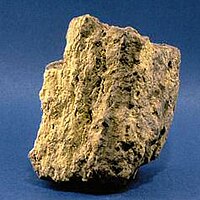
Photo from wikipedia
Characterizing the structure of the critical zone (CZ), which is often tens of metres deep, is challenging and crucial to understand earth surface processes. Existing findings on the effect of… Click to show full abstract
Characterizing the structure of the critical zone (CZ), which is often tens of metres deep, is challenging and crucial to understand earth surface processes. Existing findings on the effect of topography on CZ thickness focused exclusively on mountainous regions with steep slopes, not considering low hilly regions with gentle slopes. Seismic refraction and borehole surveys were conducted to characterize the effects of topography on a red soil CZ structure in the low hilly region of Jiangxi Province, subtropical China. This CZ is derived from Quaternary red clay (QRC) overlying Cretaceous sandstone bedrock. Regolith with a thickness of 8.2–9.5 m consisted of an upper layer of QRC (4.8–6.2 m thick) and a lower layer of weathered sandstone (2.6–4.0 m thick). The boundary between weathered and unweathered sandstone was identified by a Ca depletion profile and calcite weathering front. The boundary between the QRC and weathered sandstone was identified by morphological and textural features and a feldspar weathering front. The QRC had seismic refraction velocities <1.3 km s−1, the weathered sandstone had velocities of 1.3–1.7 km s−1, while the sandstone bedrock had velocities >1.7 km s−1. Following the profile sequence downslope, regolith thickness decreased linearly with decreasing ground elevation. The linear fitted regression slope was <1. This was predominantly determined by QRC thickness, which in turn was mainly controlled by the difference between slopes of ground and bedrock surface and by surface erosion. Following the profile sequence across the slope, regolith thickness decreased linearly with decreasing ground elevation, with a slope of ~1. This was controlled by QRC thickness, which in turn was mainly controlled by surface erosion only, since the bedrock surface was nearly level. These results suggest that topography can control CZ structure in hilly regions with gentle slopes.
Journal Title: Earth Surface Processes and Landforms
Year Published: 2022
Link to full text (if available)
Share on Social Media: Sign Up to like & get
recommendations!